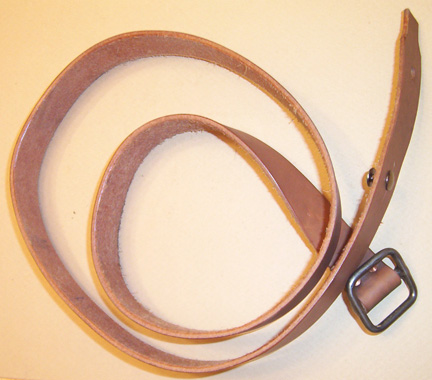The Netherlands
Dutch M95 Mannlicher Slings
 |
 |
Reproduction from the Netherlands
by H. deBruin of The NetherlandsThe first sling (a) was used by the riding units (cavalry), and made of leather belt. The broad part was made of cotton band, we call (in NL) 'singel'. This singel was colored dark blue. It was 48 cm long, 5,8 cm wide. The short end of the leather belt was 14 cm, the long end 49 cm with a H-shaped buckle. The long end was to bend back and attached to the buckle with the help of a brass or metal stud. The short end (NL: stootlus) was to be attached to the top of the carbine with help of a stud. At the long end there was a hook (same one the British army used!) to attach this end to the lower side of the carbine. This hook however was since 1923 of a type what could swing on it's axis. Before that it was rigid. In the first years the sling was attached without this hook, by simply attaching the belt through the swivel and close it with the stud. The artillery used this sling as well, although the color of the single went from dark blue to olive-drab (khaki) in 1926! This sling is known under three (!) names:
Karabijnriem cavalerie (1895-1925) (Engl: Carbine sling for Cavalry)
Karabijnriem Cavalerie en Veldartillerie (c. sling for cavalry and field
artillery) since 1926
Karabijnriem Beredenen (c. sling Riding troops) since 1930The second sling called 'Karabijnriem Beredenen Nieuw Model' (your Dutch
language is improving! You already understood what I said here!) The same model as the sling written about before, but now with singel of a grey-green color. The studs were no longer of Berlin Silver, but now they all were made of brass (since 1933).Third model! Karabijnriem Wielrijders (c. sling cyclists). Picture (b). Two pieces of grey-green cotton singel, 8.7 cm wide. The long end 40 cm, the short end 24 cm. On the long singel was made a long end of leather belt of about 35 cm, with two holes, a stud, a H-shaped buckle and a hook. On the other side of the long single a leather strip which held a hook. The short singel held a leather belt of 14 cm with two holes and a stud, and on the other side a leather strap holding a D-shaped ring. All metal parts were black-burned or black varnished. The 14 cm leather strap (stootlus) was to attached to the upper swivel, the hook on the 35 cm leather strap was to attached at the lower swivel. The sling could also be attached at the lower swivel not using the hook. Since 1934 (3. aug. 1934) this sling was known as karabijnriem "B".
De karabijnriem Wielrijders N.M. (See I was right about your Dutch) Image
(c).
Made of singel, 48 cm long and 8.6 cm wide. De stootlus 14 cm and with a stud and two holes. The long leather belt was 49 cm and had two
holes, a stud, a hook and the H-shaped buckle. Since 1934 an extra leather belt has been in use, to lengthen the sling. This was a short (how short the books don't tell me) leather strap with on one side a D-shaped ring and the other side two holes and a stud. This was to be attached to the 49 cm long leather strap. You'll understand that only the larger soldiers needed this extra strap. The sling was used for all models 1, 3 and 4.Later on, the slings karabijnriem beredenen, karabijnriem beredenen N.M. and
the karabijnriem Wielrijders N.M. were gathered under one name: Karabijnriem
"A" (since 3 aug. 1934).
Hembrug rifle sling also used on the Engineers carbine
(Reproduction)
